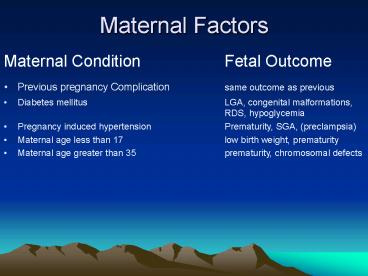Maternal Factors - PowerPoint PPT Presentation
1 / 11
Title:
Maternal Factors
Description:
Diabetes mellitus LGA, congenital malformations, RDS, hypoglycemia ... Drug Use Placental abruption, IUGR, prematurity, CNS abnormalities, withdrawal disorders ... – PowerPoint PPT presentation
Number of Views:38
Avg rating:3.0/5.0
Title: Maternal Factors
1
Maternal Factors
- Maternal Condition Fetal Outcome
- Previous pregnancy Complication same outcome as
previous - Diabetes mellitus LGA, congenital
malformations, RDS, hypoglycemia - Pregnancy induced hypertension Prematurity, SGA,
(preclampsia) - Maternal age less than 17 low birth weight,
prematurity - Maternal age greater than 35 prematurity,
chromosomal defects
2
Maternal Factors
- Maternal Condition Fetal Outcome
- Placenta previa prematurity, bleeding, SGA
- Placenta abruptio Fetal asphyxia, bleeding
- Alcohol consumption SGA, CNS dysfunction,
mental retardation, facial dysmorphology - Smoking SGA, prematurity, mental
retardation, SIDS - Drug Use Placental abruption, IUGR,
prematurity, CNS abnormalities,
withdrawal disorders
3
Fetal Assessment
- Ultrasound
- Widely used non-invasive technique
- Evaluate fetal anatomy, growth, position
- Localize placenta w/in placenta
- Measure amniotic fluid volume
- Estimate fetal growth over time
- Used to guide amniocentesis
4
Fetal Assessment
- Amniocentesis
- Commonly performed invasive procedure
- Needle inserted (sterile condition) into amniotic
sac - Evaluate fetal lung maturation
- Rh isoimmuniztion severe anemia 2nd to hemolysis
- Assess fetal chromosomal abnormality
5
Fetal Assessment
- Nonstress Test and Contraction Stress Test
- Monitor fetal heart rate (FHR)
- Nonstress (NST) response when fetus moves
- Reactive.. Rise in FHR at least 15 bpm lasting
more 15 seconds - Highly correlated with normal uteroplacenta
function - No change in maternal clinical status
- Normal fetal survival if perfromed w/in 1 week of
delivery
6
Fetal Assessment
- Contraction Stress Test
- Continuously monitoring FHR during uterine
contractions - Stimulated by oxytocin
- Normal uterine contraction fetal P02 drop 12 mm
Hg slowing FHR - Known as late deceleration
- Negative CST no late deceleration of FHR
w/contraction - Contraction occur w/ frequency of 3 per 10
minutes - Positive CST late decelerations w/every
contraction - Suspicious CST some but not all contractions
accompanied w/late deceleration - Abnormal CST may prompt further evaluation of
delivery
7
Fetal Assessment
- Fetal BioPhysical Profile
- Variable
- Fetal breathing movements
- Gross body movement
- Fetal tone
- Reactive FHR
- Qualitative amniotic fluid volume (AFV)
8
Fetal Assessment
- Fetal BioPhysical Profile
- Likened to Apgar score
- Score of 0 2
- Four assessed by ultrasound fetal breathing,
fetal tone, gross body movement, and amniotic - Fifth determine by NST
- BRP score
- 8 10 considered normal
- Score of 6 repeat w/in 24 hours
- BRP 0 4 clearly abnormal
- Associated with poor perinatal outcomes
- Immediate delivery
9
Fetal Assessment
- Blood Gas Values
- Fetal Scalpfetal scalp puncture
- First Stage Labor Second Stage Labor
- pH 7.33 7.29
- PC02 44 46
- P02 22 16
- HC03- 20 17
- Scalp blood pH
- greater than 7.25 reassuring
- Less than 7.15 high risk of fetal acidemia
10
Fetal Assessment
- Blood Gas Values
- Umbilical Cord at birth
- Umbilical artery Umbilical Vein
- pH 7.24 7.32
- PC02 49 38
- P02 16 27
- HC03- 19 20
- Scalp blood pH
- greater than 7.25 reassuring
- Less than 7.15 high risk of fetal acidemia
11
Fetal Assessment
- Blood Gas Values
- Arterial Sample after Birth
- 5- 10 minutes 30 minutes 60 minutes
- pH 7.21 7.30 7.33
- PC02 46 38 36
- P02 50 54 64
- HC03- 17 18 19
- Scalp blood pH
- greater than 7.25 reassuring
- Less than 7.15 high risk of fetal acidemia

